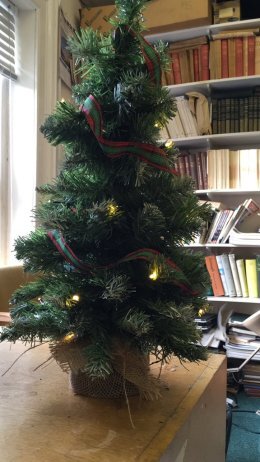Two-tree or not two-tree?
So the tree is now up in the NIPNP office, and as well as ensuring it is now acceptable (and expected) to have a mince pie with every coffee break, it has also inspired my first (and appropriately tree-themed) blog post.
When deciphering Irish place-names, there are a number of factors that must be taken into consideration, none are as significant than the language shifts that have taken place in Ireland, in particular the introduction of English in the 12th and 16th centuries. During these periods, many Irish place-names were given English spellings, and often this resulted in the obscuring of the original meaning of the name, now hidden in Anglicised forms. The past century has seen a significant amount of scholarly work on place-names and quite often we can quite accurately predict the original form from the anglicised form with elements such as -derry, from doire ‘oak-wood’ in places like Ballinderry (Baile an Doire ‘townland of the oak-wood) or Derrydrummuck (Doire Droma Muc‘oakwood of the ridge of pigs’). Another relatively straight-forward element is -skeagh from the element sceach ‘hawthorn’ in names such as Skeagh (An Sceach ‘the hawthorn bush’) Aughnaskeagh (Achadh na Sceiche ‘field of the thorntree’) and even Skegoneil (Sceitheog an Iarla ‘ the earl’s thorn bush’).
The process becomes a little trickier when an anglicised element might possibly refer to more than one Irish form, such as is the case with the element kil- which could represent either cill ‘church, churchyard’, or coill ‘wood’. In these cases however, it is often possible to identify one as more possible than the other by identifying some corroborative evidence for one form (most usually in the form of a church, church ruins or a graveyard).
Where we really have our work cut out for us is when subtle morphological changes have been lost in the process of anglicisation. Consider the element crann ‘tree’, and its plural counterpart crainn ‘trees’. An Anglicised form such as Crann, a townland in Co. Armagh, could conceivably derive from either the singular form, or the plural form as internal vowel changes such as the palatalisation that forms crainn from crann are very often lost or corrupted through the process of Anglicisation.
Now, if one were to come across a name like Ballycran, as we do in Co. Down, we also need to consider what the genitive form (the way it is spelt when it qualifies or modifies another element) looks like. In the case of crann, the genitive form is either crainn (in the singular) or crann (in the plural). For Ballycran, therefore, it is pretty much impossible to be sure if the original form is Baile Crainn ‘townland of the tree’, or Baile Crann ‘townland of the trees’. Luckily for this particular one, analysis of the historical forms here reveals that it is neither, and the original name is actually Baile Crannaí ‘townland of the tree area’, featuring the element crannach which means ‘grove, wooded place’ (DIL). So we are off the hook for now. If only all the trees in Irish place-names were those that appear as billy- from bile ‘a large or sacred tree with ritual or historical attributes’, and of which we would be sure there was only one! Maybe that’s what we will call our little tree in the office, although given that it’s not much bigger than the kettle, crainnín ‘little tree’ might be slightly more appropriate.
Now where are those mince pies…..
(Originally published December 2018)

